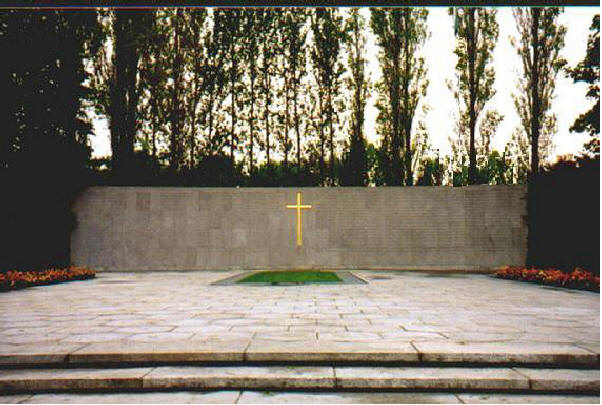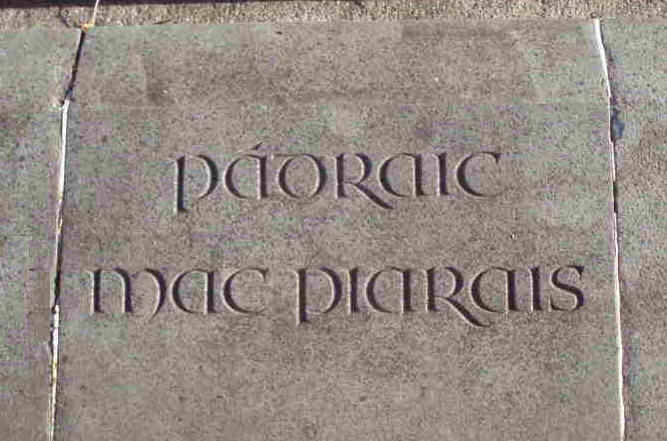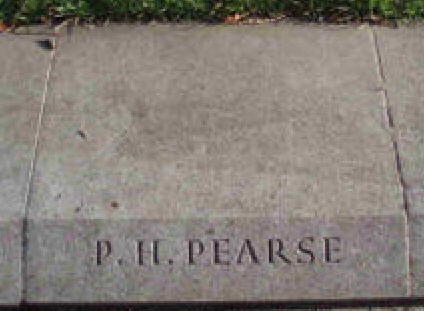|
Padraic Henry Pearse (1879 – 1916)
Educator, linguist, lawyer, poet, playwright,
author, military leader
 Padraic Henry Pearse, the second of four children, was born on November
10, 1879 to James Pearse and Margaret Pearse (née Brady). Padraic Henry Pearse, the second of four children, was born on November
10, 1879 to James Pearse and Margaret Pearse (née Brady).
His father, James, who was born in England, was a mason and monumental
sculptor who sculpted the pediment adorning the Bank of Ireland
(formerly the Parliament House) in College Green and the 12 statues in
the niches of the tower of John's Lane Church located on Thomas Street
in Dublin.
His mother, Margaret, who was born in Dublin was elected a Sinn Fein
member to the 2nd Dail Eireann that convened in August 1921 and
functioned until June 1922. After the Dail accepted the controversial
Anglo-Irish Treaty by 64 to 57 votes on January 7th 1922, Margaret
together with the other opposing Sinn Fein members left the Dail
(1).
During his childhood Pearse was greatly influenced by his father’s
embrace of libertarian ideals that embodied political and personal
freedom, civil liberties and social justice. The embrace of these ideals
by Pearse gave substance to his evolving censorious attitude towards
cultural imperialism and colonial rule, particularly as applied to
Ireland and its people. In addition to his father’s influence, which was
significant, he grew up in midst of the Irish Literary Revival, a
movement associated with the revival of interest in Ireland's Gaelic
heritage and the consequential growth of Irish nationalism. Pearse would
go on to become one of the movements foremost contributors through both
his literary talents that included the publication of bilingual poems,
stories and plays and his devotion to the Irish nation that he and his
comrades set forth to liberate on Easter Monday 1916.
Pearse attended a private school before enrolling at the Christian
Brothers School in Westland Row. He was an excellent student in all his
subjects, particularly, Irish history and the Irish language, subjects
that he grew to love. He was an honors Irish language student each year
and by the age of seventeen was an accomplished Irish language writer.
He was awarded a scholarship to the Royal University from whence
he graduated with a degree in Modern Languages in 1900. He also studied
law at Trinity College Dublin and enrolled as a Barrister-at-Law at the
King’s Inn. He was called to the Bar in 1901.
His love for the Irish language found expression as a member of the
Gaelic League, a nationalistic leaning organization he joined in 1896 at
the age of sixteen. The organization was founded in 1893 by Fr. Eugene
O'Growney and Douglas Hyde and others Irish language enthusiasts to
restore and preserve the Irish language. As one of its most devoted and
enthusiastic member Pearse was appointed to its Executive Committee in
1898.
Throughout his life Pearse remained dedicated to the revival and
preservation of the Irish language. To that end he utilized his many
talents included writing and publishing stories, poems and plays,
teaching Irish classes at Newman House the precursor of University
College Dublin (UCD), traveling to the west of Ireland and the Aran
Islands on behalf of the Gaelic League, lecturing in Irish at UCD and
editing the Gaelic Leagues newspaper ’An Claidheamh Soluis’ (Sword of
light). Amongst his many publications were Poll an Piobaire (The
Piper’s Cave) and Iosagan agus Sgealta Eile (Little Jesus and
other Stories).
On a visit to Rosmuc in Connemara in April 1903 as an examiner for the
Gaelic League he decided to build a holiday home there. He bought a site
overlooking Loch Eiliúrach where he had a two-bedroom thatched cottage
built. He loved the area and the people and spent his summer holidays
there writing and mastering his command of the Irish language.
In September of 1908 Pearse and Thomas MacDonagh founded St Enda’s
(Scoil Éanna) Secondary School for boys in Ranelagh, Dublin. He did so
because he believed that the Irish School system did not cater to the
cultural and educational needs of Irish children but, rather to the task
of turning Irish children into good English subjects. One aim of the
school was to teach as many subjects as possible in Irish. His staff
included, in addition to himself and MacDonagh, Con Colbert, his brother
William and Joseph M. Plunkett. Guest lecturers included amongst others,
Ella Young, Douglas Hyde,
Eoin MacNeill and W.B. Yeats. To accommodate its rapid expansion the
school relocated to The Hermitage in Rathfarnham, the former home
of Sarah Curran, Robert Emmet’s beloved.
The Hermitage was selected by Pearse primarily because of its
connection to Robert Emmet and Sarah Curran, both of whom he greatly
admired for their beliefs, tragic liaison and ultimate fate.
The spacious grounds surrounding The Hermitage were used by
Countess Markievicz’s Fianna boys and the Irish Volunteers for training
and drilling exercises. In the weeks leading up to the Rising, a group
of university students, former students of St. Enda’s referred to as the
“The Dogs” used the school basement to make bombs. Fifteen of “The Dogs”
took part in the Rising.
Up until the formation of the Ulster Volunteers, (a Unionists militia
founded in 1912 to prevent the implementation of the 3rd Home Rule for
Ireland) Pearse’s could more accurately be described as a cultural
nationalist whose focus was on awakening and nurturing Ireland’s unique
cultural identity within the restraints of Home Rule. As a student of
Irish history, he realized that the Unionists opposition to the
enactment of the Home Rule Bill would doom it to the ashes of history,
the same fate that befell the previous two Home Rule Bills, albeit for
different reasons.
That realization was a pivotal chapter in his Pearse’s life. From that
time on his attitude towards British rule in Ireland became more hostile
and militant, having decided that Ireland’s future would best be served
by a complete break from England and the establishment of a sovereign
all-Ireland Republic. His new resolve brought him closure in his
thinking to Republican activists including
Thomas J. Clarke, Sean
MacDiarmada, Bulmer Hobson and Eamonn Ceannt.
Pearse’s oratorical skills combined with his extensive knowledge of
Irish history and contemporary politics made him one of the most sought
after speakers at the many cultural and political functions taking place
around Ireland at that time. In 1913,
Thomas Clarke, who had
returned from the United States in December of 1907 to help reorganize
the Irish Republican Brotherhood (IRB), heard Pearse speak at one of the
aforementioned functions and invited him to deliver the 1913 oration at
the graveside of Wolfe Tone in Bodenstown in Co. Wicklow. (The Wolfe
Tone commemoration was, and continued to be, an annual event sacred to
Irish Republicans). It was at that commemoration that Pearse
publicly identified himself with the Republican cause when he,
knowingly, began his speech with these words;
"We have come to the holiest place in Ireland: holier to us than the
place where Patrick sleeps in Down. Patrick brought us life, but this
man died for us. And though many before him and some since have died in
testimony of the truth of Ireland's claim to nationhood, Wolfe Tone was
the greatest of all that have died for Ireland whether in old time or in
new. He was the greatest of Irish nationalists. I believe he was the
greatest of Irish men. And if I am right in this I am right in saying
that we stand in the holiest place in Ireland and that the holiest sod
of a Nation's soil is the sod where the greatest of her dead lies
buried."
In mid-1913 Pearse began contributing articles to the IRB newspaper
Irish Freedom, a monthly publication founded by IRB members, Sean
MacDiarmada, Bulmer Hobson and Denis McCullough. He became a member of
the Irish Volunteers and was one of the speakers at its inaugural
meeting in November of 1913. By the end of 1913 Pearse had also become a
member of the IRB. His indomitable spirit and unequivocal commitment to
Irish Freedom coupled with his leadership qualities propelled him to
prominence within the ranks of both organizations. He was elected
principle speaker and Director of Organization of the Irish Volunteers.
As Director of Organization he was authorized to issue orders on behalf
of the Chief of Staff, Eoin MacNeill.
In February of 1914 he embarked on a lecture and fundraising tour in the
United States to raise money to maintain St. Enda’s and to arm the Irish
Volunteers. Although his base of operation was in Harlem in New York
City, he lectured and gave speeches in various locations up and down the
east coast including Wilmington (Delaware), Philadelphia (Pennsylvania),
Springfield (Massachusetts), Providence (Rhode Island), and New Rochelle
(New York). As an ardent admirer of the United Irishmen of 1798 and 1803
his lectures included, in addition to the prevailing political situation
in Ireland, insights into the lives and travails of
Wolfe Tone, James
Orr, Michael Dwyer, Robert Emmet, Sarah Curran and other heroes and
martyrs of that historic era.
Interspersed with his lecture tour were meetings with Irish-American
political activists including Clan na Gael leaders
Joseph McGarrity and
John Devoy. His
meetings with McGarrity and Devoy were focused on the feasibility of
launching another Rising in Ireland to oust the British and establish a
sovereign all-Ireland Republic. They discussed the implications of such
a drastic undertaking including the planning, financing and
transatlantic coordination necessary to carry it out. After completing
his tour in May of 1914, Pearse left the U.S. assured that the
Irish-American leadership was on board when the worsening situation in
Ireland left no other choice but, insurrection. Despite the assurances
of help from Clan na Gael, Pearse had no illusions as to the probable
outcome of such an undertaking. At best, he hoped that if it ended in
failure and, if history proved correct, the execution of its leaders,
their sacrifices would ignite the proverbial fuse that would culminate
in a successful nationwide War of Independence.
On July 14, 1914, the yacht
Asgard openly unloaded 1,000 rifles and ammunition at Howth for
the Irish Volunteers. The rifles were purchases in Germany by a group of
Irish Republican activists and supporters including Erskine and
Molly Childers,
Roger Casement,
Alice Stopford Green and Mary Spring Rice. Molly Childers and Spring
Rice raised over £2000 to purchase the guns and ammunition. The Childers
provided their yacht, Asgard, to run the guns into Ireland. The guns
were dispersed and hidden in various locations throughout Dublin
including St. Enda’s.
In September 0f 1914, when John Redmond, leader of the Irish
Parliamentary Party, split the Volunteers, Pearse assumed command of the
remaining Volunteers who ignored Redmond’s call to join the British army
and fight for the British Empire in the WWI.
Pearse’s increasing involvement with Irish Volunteers and the IRB
required more of his time and efforts as the clock wound down to the
pending Rising. In March of 1915 he was appointed to the Supreme Council
of the IRB by Thomas Clarke. He, together with Joseph Plunkett and
Eamonn Ceannt served on a secret committee responsible for drawing up
plans for the Rising. The committee later expanded into the Military
Council with the inclusion of Sean MacDiarmada, James
Connolly, and Thomas MacDonagh.
On August 1, 1915 Pearse gave a graveside oration at the funeral of
O’Donovan Rossa
in Glasnevin Cemetery. He ended his oration with the following words:
“Life springs from death; and from the graves of patriot men and
women spring living nations. The Defenders of this Realm have worked
well in secret and in the open. They think that they have pacified
Ireland. They think that they have purchased half of us and intimidated
the other half. They think that they have foreseen everything, think
that they have provided against everything; but, the fools, the fools,
the fools! – They have left us our Fenian dead, and while Ireland holds
these graves, Ireland unfree shall never be at peace”. (click
here for the entire oration)
In the early months of 1916 Pearse published three pamphlets The
Separatist Idea, The Spiritual Nation, and
The Sovereign People. The pamphlets elaborated on one of his
earlier publications Ghosts wherein he contended that the ghosts
of dead men bequeathed to us living men a trust to do what they wanted
i.e., continue the quest for Irish freedom and sovereignty.
In the waning months of 1915 Pearse penned the following poem titled
The
Fool addressed to his fellow country men and women who did not share his
vision:
"The Lawyers have sat in Council, the men with the keen long faces,
and said This man is a fool, and others have said he blasphemeth; and
the wise have pitied the fool who strove to give a life to a dream that
was dreamed in the heart and that only the heart can hold. O Wise Men,
riddle me this: What if the dream come true, What if the dream come true
and millions unborn shall dwell in the house that I shaped in my heart?
On April 3, 1916, Pearse, as the Volunteers' Director of Organization,
issued orders to the Volunteers to assemble for three days of "parades
and maneuvers" beginning on Easter Sunday. IRB members within the ranks
of the Volunteers would know these were orders to begin the Rising,
while the British authorities would dismiss the maneuvers as
commonplace. In the hours leading up to the Rising Pearse was appointed
Commandant General and Commanding in Chief of the Army of the Irish
Republic, and President of the Provisional Government. When McNeill, who
initially supported the Rising heard that the
Aud was intercepted and that Roger Casement was captured by the
British, he countermanded Pearse’s orders, causing general confusion
within the ranks of the Volunteers Although the Rising commenced on
Easter Monday, April 24, a day later than originally planned, the
confusion caused by McNeill’s action limited its scope to Dublin. The
other units that mobilized outside of Dublin had little or no impact on
the outcome.
At noon on Easter Monday Pearse read the Proclamation from the steps of
the General Post Office on Sackville St. (now O’Connell St). Immediately
afterwards units of the Volunteers, the Citizen’s Army Cumann na mBan,
na Fianna Eireann and the Hibernian Rifles deployed to various garrisons
throughout Dublin. Hostilities began shortly afterwards when a
contingent of Volunteers and Fianna members attacked the Magazine Fort
in the Phoenix Park. As more British troops arrived from England the
fighting incrementally intensified to the point where the volunteers
were overpowered with men and armaments. In all, it took 20,000 British
troops to overpower 1,500 freedom fighters.
On Friday evening, April 27, Pearse, James Connolly, Thomas Clarke, Sean
MacDiarmada and Joseph Plunkett left the GPO for Hanlon’s fish shop on
Moore St. where, after considering their options decided to surrender to
prevent further loss of life. On Saturday afternoon Nurse Elizabeth
O’Farrell, a member of Cumann na mBan, under a flag of truce met with
General Lowe with a message from Pearse stating that he wished to
negotiate surrender terms. Eventually. Pearse surrendered
unconditionally. The surrender order did not reach some of the outposts
until the Sunday April 30.
After a Field General Court Martial on May 2, 1916 Pearse was executed
by firing squad at 3.30 the following morning, May 3, 1916. Fifteen
other leaders of the Rising were also executed by firing squads. Roger
Casement was hanged in England on August 1, 1916. Five of those executed
were teachers at St Enda’s including, in addition to Pearse, his brother
William, Joseph Plunkett, Thomas MacDonagh and Con Colbert.
The following quote is taken from Pearse’s closing statement at his
court martial on May 2:
You cannot conquer Ireland; you cannot extinguish the Irish passion for
freedom. If our deed has not been sufficient to win freedom, then our
children will win it by a better deed.”
Notes:
1) After the vote, pro-treaty members led by Arthur Griffith and Michael
Collins left Sinn Fein and formed a new Free State party known as Cumann
na nGaedhael. De Valera stayed on as leader of Sinn Fein.
On January 10, 1921 Arthur Griffith was elected President of Dail
Eireann. Two days later, as head of the Delegation to London that signed
the Treaty, he called into existence the rival Parliament of Southern
Ireland, created by the British Government of Ireland Act 1920, to
ratify the Treaty and set-up a Provincial Government. In recognizing the
Southern Ireland parliament as the legitimate authority to ratify the
Treaty, Griffith ignored the fact that the Government of Ireland Act
1920 was rejected by the deputies elected to Dail Eireann in May 1921.
Contributor:
Tomás Ó Coısdealbha
cemetery
NAME:
Arbour
Hill
Cemetery
ADDRESS:
Arbour
Hill,
Dublin
West,
Dublin,
Co.
Dublin
EXECUTED Leaders
of
the
1916
rising
burial
plot



|